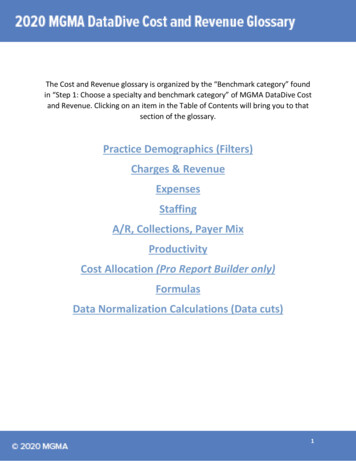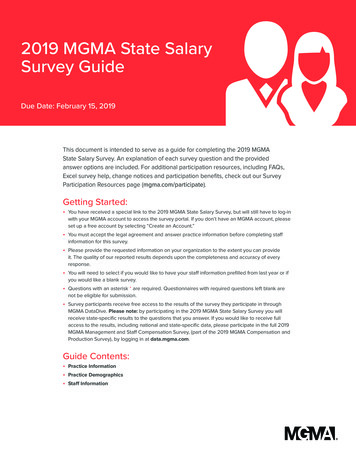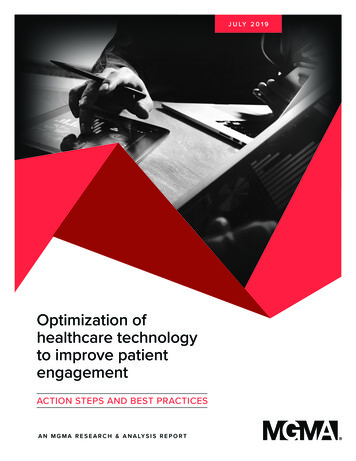
Transcription
The Cost and Revenue glossary is organized by the “Benchmark category” foundin “Step 1: Choose a specialty and benchmark category” of MGMA DataDive Costand Revenue. Clicking on an item in the Table of Contents will bring you to thatsection of the glossary.Practice Demographics (Filters)Charges & RevenueExpensesStaffingA/R, Collections, Payer MixProductivityCost Allocation (Pro Report Builder only)FormulasData Normalization Calculations (Data cuts)1
Practice Demographics (Filters)Accountable Care Organization (ACO)PRO REPORT BUILDER ONLYA group of coordinated health care providers who form a healthcare organization characterized by a payment and care deliverymodel that seeks to tie provider reimbursements to quality metrics and reductions in the total cost of care for their population ofpatients. The ACO is accountable to patients and the third-party payer for the quality, appropriateness, and efficiency of the careprovided.Ancillary/Supplementary ServicesPRO REPORT BUILDER ONLYAncillary services are those services that supplement the routine (professional) services personally performed by the practice’sprovider staff. Such services are billed under separate CPT codes and reimbursed separately, either by third-party payers and/orpatients. Examples of ancillary services include: Advanced Radiology, Aesthetics and Cosmetic Services,Allergy/Asthma/Immunology, Ambulatory Surgery Center, Audiology/Hearing Aid(S)/Center, Clinical Laboratory Services,Complementary Alternative Medicine, Drug Administration, Durable Medical Equipment (DME), General Radiology, HealthEducation/Counseling Services, Optical Shop, PT/OT/Cardiac Rehabilitation, Radiation Therapy, and Sleeping Lab/Center.Care Team ModelPRO REPORT BUILDER ONLY - ANESTHESIOLOGY PRACTICES ONLYAccording to the American Society of Anesthesiologists, the care team model consists of anesthesiologists supervising qualifiednonphysician anesthesia providers and/or resident physicians who are training in the provision of anesthesia care. Theanesthesiologist may delegate patient monitoring and appropriate tasks to these nonphysician providers while retaining overallresponsibility for the patient.Members of the Anesthesia Care Team work together to provide the optimal anesthesia experience for all patients. Coremembers of the anesthesia care team include both physicians (anesthesiologist, anesthesiology fellow, anesthesiology resident)and nonphysicians (anesthesiologist assistant, nurse anesthetist, anesthesiologist assistant student, student nurse anesthetist).Other healthcare professionals also make important contributions to the perianesthetic care of the patient.To provide optimum patient safety, the anesthesiologist directing the Anesthesia Care Team is responsible for management ofteam personnel, patient pre-anesthetic evaluation, prescribing the anesthetic plan, management of the anesthetic, postanesthesia care and anesthesia consultation.Demographic ClassificationMetropolitan area (population of 50,000 or more): The county in which the practice is located is defined as a metropolitan(metro) county by the Office of Management and Budget (OMB), based on recent Census Bureau data.Nonmetropolitan area (population of 49,999 or fewer): The county in which the practice is located is defined as anonmetropolitan (nonmetro) county by the Office of Management and Budget (OMB), based on recent Census Bureau data.Demographic Classification (expanded)PRO REPORT BUILDER ONLYMetro – Counties in metro areas of fewer than 250,000 population: The county in which the practice is located is CensusBureau defined urbanized area with a population less than 250,000.Metro – Counties in metro areas of 250,000 to 1 million population: The county in which the practice is located is CensusBureau defined urbanized area with a population of 250,001 to 1,000,000.Metro – Counties in metro areas of 1 million population or more: The county in which the practice is located has a populationof 1,000,001 or more.2
Nonmetro - Completely rural or less than 2,500 urban population: The county in which the practice is located is referred to as“rural.” It may or may not be adjacent to a metro area and has a population less than 2,500.Nonmetro – Urban population of 2,500 to 19,999: The county in which the practice is located is referred to as “rural.” It may ormay not be adjacent to a metro area and has a population between 2,500 and 19,999.Nonmetro - Urban population of 20,000 or more: The county in which the practice is located is referred to as “rural.” It may ormay not be adjacent to a metro area and has a population of 20,000 or more.EHR YearsPRO REPORT BUILDER ONLYThe number of years that an EHR system has been implemented at a practice. 1 or less 2 to 5 6 to 10 11 or moreFederally Qualified Health Center (FQHC)PRO REPORT BUILDER ONLYA reimbursement designation that refers to several health programs funded under Section 330 of the Public Health Service Act ofthe US Federal Government. These 330 grantees in the Health Center Program include: Community Health Centers which serve a variety of underserved populations and areas; Migrant Health Centers which serve migrant and seasonal agricultural workers; Health Care for the Homeless Programs which reach out to homeless individuals and families and provide primary andpreventive care and substance abuse services; and Public Housing Primary Care Programs that serve residents of public housing and are located in or adjacent to the communitiesthey serve.FQHCs are community-based organizations that provide comprehensive primary and preventive health, oral, and mentalhealth/substance abuse services to persons in all stages of the life cycle, regardless of their ability to pay.Fiscal YearThe corporate year established by the practice for business purposes. For many practices, this is January through December ofthe same year. The data reported is representative of the completed fiscal year.Full Time Equivalent (FTE)A measure based upon the number of actual hours worked regardless of whether it’s spent in clinical or nonclinical activities. A1.0 FTE provider works the number of hours the practice considers to be the minimum for a normal workweek, which could be37.5, 40, 50 hours, or some other standard. Regardless of the number of hours worked, a provider cannot be counted as morethan 1.0 FTE.3
Geographic SectionEastern Section:ConnecticutDelawareDistrict of ColumbiaMaineMarylandMassachusettsNew HampshireNew JerseyNew YorkNorth CarolinaPennsylvaniaRhode IslandVermontVirginiaWest VirginiaWestern MontanaNevadaNew MexicoOregonUtahWashingtonWyomingMidwest kaNorth DakotaOhioSouth DakotaWisconsinSouthern yLouisianaMississippiMissouriOklahomaSouth CarolinaTennesseeTexasHealth and Human Services (HHS) RegionsPRO REPORT BUILDER ONLYHHS Region 1:ConnecticutMaineMassachusettsNew HampshireRhode IslandHHS Region 2:New JerseyNew YorkHHS Region 3:DelawareDistrict of ColombiaMarylandPennsylvaniaVirginiaWest VirginiaHHS Region 4:AlabamaFloridaGeorgiaKentuckyMississippiNorth CarolinaSouth CarolinaTennesseeHHS Region 5:IllinoisIndianaMichiganMinnesotaOhioWisconsin4
HHS Region 6:ArkansasLouisianaNew MexicoOklahomaTexasHHS Region 7:IowaKansasMissouriNebraskaHHS Region 8:ColoradoMontanaNorth DakotaSouth DakotaUtahWyomingHHS Region 9:ArizonaCaliforniaHawaiiNevadaHHS Region 10:AlaskaIdahoOregonWashingtonLegal OrganizationBusiness Corporation: A for-profit organization recognized by law as a business entity separate and distinct from itsshareholders. Shareholders need not be licensed in the profession practiced by the corporation.Limited Liability Company: A legal entity that is a hybrid between a corporation and a partnership, because it provides limitedliability to owners like a corporation while passing profits and losses through to owners like a partnership.Not-For-Profit Corporation/Foundation: An organization that has obtained special exemption under Section 501(c) of theInternal Revenue Service code that qualifies the organization to be exempt from federal income taxes. To qualify as a taxexempt organization, a practice or faculty practice plan would have to provide evidence of a charitable, educational, or researchpurpose.Partnership: An unincorporated organization where two or more individuals have agreed that they will share profits, losses,assets, and liabilities, although not necessarily on an equal basis. The partnership agreement may or may not be formalized inwriting.Professional Corporation/Association: A for-profit organization recognized by law as a business entity separate and distinctfrom its shareholders. Shareholders must be licensed in the profession practiced by the organization.Sole Proprietorship: An organization with a single owner who is responsible for all profit, losses, assets, and liabilities.Other: Legal organization is not one of the aboveMinor Geographic RegionsPRO REPORT BUILDER ONLYNortheast Region:ConnecticutMaineMassachusettsNew HampshireRhode IslandVermontNorth Atlantic:New JerseyNew YorkPennsylvaniaNorthwest:IdahoOregonWashingtonMid Atlantic:DelawareDistrict of ColumbiaMarylandVirginiaWest North CarolinaSouth CarolinaTennesseeEastern Midwest:IllinoisIndianaKentuckyMichiganOhioUpper Midwest:IowaMinnesotaNebraskaNorth DakotaSouth DakotaWisconsinLower asRocky Mountain:ArizonaColoradoMontanaNevadaNew MexicoUtahWyomingCalifornia,Alaska, Hawaii:AlaskaCaliforniaHawaiiNumber of Branch ClinicsPRO REPORT BUILDER ONLYThe primary clinic location is the clinic with the most FTE physicians out of all the practice branches. A branch or satellite clinic is asmaller clinical facility for which the practice incurs occupancy costs such as lease, depreciation and utilities. A branch is in aseparate location from the practice’s principal facility. Merely having a physician practice in another location does not qualify thatlocation as a branch or satellite clinic. For example, if a physician sees patients in a hospital, this would not normally be counted as abranch or satellite clinic unless the practice pays rent for the space.5
Organization OwnershipHospital/IDS Owned: Hospital: A hospital is an inpatient facility that admits patients for overnight stays, incurs nursing care costs, and generatesbed-day revenues. Integrated Health System or Integrated Delivery system (IDS): An IHS/IDS is a network of organizations that provide orcoordinate and arrange for the provision of a continuum of health care services to consumers and is willing to be heldclinically and fiscally responsible for the outcomes and the health status of the populations served. Generally consisting ofhospitals, physician groups, health plans, home health agencies, hospices, skilled nursing facilities, or other providerentities, these networks may be built through “virtual” integration processes encompassing contractual arrangements andstrategic alliances as well as through direct ownership. Management Services Organization (MSO): An MSO is an entity organized to provide various forms of practicemanagement and administrative support services to health care providers. These services may include centralized billingand collections services, management information services, and other components of the managed care infrastructure.MSOs do not actually deliver health care services. MSOs may be jointly or solely owned and sponsored by physicians,hospitals or other parties. Some MSOs also purchase assets of affiliated physicians and enter into long- term managementservice arrangements with a provider network. Some expand their ownership base by involving outside investors to helpcapitalize the development of such practice infrastructure. Physician Practice Management Company (PPMC): A PPMC is an entity that maintains full or partial ownership interest in,and provides management services to, multiple physician organizations. PPMCs may own practices that span multiplespecialties or may be focused on a single specialty such as emergency medicine or hospital medicine.Physician Owned: Nonphysician Providers: Any nonphysician provider (e.g. nurse practitioners, physical therapists, etc.) duly licensed andqualified under the law of jurisdiction in which treatment is received. Physicians: Any Doctor of Medicine (MD) or doctor of osteopathy (DO) who is duly licensed and qualified under the law ofjurisdiction in which treatment is received.Other Majority Owner: Government: A governmental organization at the federal, state, or local level. Government funding is not a sufficientcriterion. Government ownership is the key factor. An example would be a medical clinic at a federal, state, or countycorrectional facility. Insurance company or Health Maintenance Organization (HMO): An insurance company is an organization thatindemnifies an insured party against a specified loss in return for premiums paid, as stipulated by a contract. An HMO is aninsurance company that accepts responsibility for providing and delivering a predetermined set of comprehensive healthmaintenance and treatment services to a voluntarily enrolled population for a negotiated and fixed periodic premium. Private Investor(s): A private investor is a company or individual that takes their own money and uses it to fund anotherorganization. Some investors have the option to invest passively, which means they give their funding and play no furtherrole, while others have a more significant role in the organization. University or Medical school: A university is an institution of higher learning with teaching and research facilitiescomprising undergraduate, graduate and professional schools. A medical school is an institution that trains physicians andawards medical and osteopathic degrees.Patient Centered Medical Home (PCMH)PRO REPORT BUILDER ONLYA care delivery model where patient treatment and care is coordinated through their primary care provider to ensure theyreceive high quality care when care is necessary. The objective is collaboration between the patient and physicians with caredelivered in a way the patient can understand. PCMHs seek to improve the quality, effectiveness, and efficiency of the caredelivered while focusing on meeting patient needs first.Practice TypeMultispecialty: A medical practice that consists of physicians practicing in different specialties.Multispecialty with Primary and Specialty Care: A medical practice that consists of physicians practicing in different specialties,including at least one of the following primary care specialties/subspecialties: family medicine (general, with obstetrics, sportsmedicine, or urgent care), geriatrics, internal medicine (general), or pediatrics (general, adolescent medicine, or sports medicine).Multispecialty with Primary Care only: A medical practice that consists of physicians practicing in more than one of the primary carespecialties listed in “Multispecialty with primary and specialty care” or the surgical specialties of obstetrics/gynecology, gynecology6
(only), and obstetrics (only).Single Specialty: This classification focuses on the clinical work of the practice and not necessarily on the specialties of the physiciansin the practice. For example, a single-specialty neurosurgery practice may include a neurologist and a radiologist.Rent vs. Own Practice SpacePRO REPORT BUILDER ONLYWhether a practice rents or owns their medical practice space.Rural Health Clinic (RHC)PRO REPORT BUILDER ONLYA clinic certified to receive special Medicare and Medicaid reimbursement. The purpose of the RHC program is to improve access toprimary care in underserved rural areas. RHCs are required to use a team approach of physicians and nonphysician providers (nursepractitioners, physician assistants, and certified nurse midwives) to provide services. The clinic must be staffed at least 50% of the timewith a nonphysician provider. RHCs may also provide other healthcare services, such as mental health or vision services, butreimbursement for those services may not be based on their allowable costs.Staffing Model for Anesthesiology PracticesPRO REPORT BUILDER ONLY – ANESTHESIOLOGY ONLYDesignation for various Anesthesiology practice staffing models. Physician Only Fewer than 1 CRNA/Anesthesia Assistant (AA) per Physician 1 CRNA/Anesthesia Assistant (AA) per Physician or moreCharges & RevenueTotal gross chargesThe sum of “Gross fee-for-service charges” and “Gross charges for patients covered by capitation contracts.”Total medical revenueThe sum of “Total net fee-for-service collections/revenue,” “Net capitation revenue,” and “Net other medical revenue.”Total medical revenue after operating costThe difference between “Total operating cost” and “Total medical revenue.”Total medical revenue after operating and nonphysician provider cost“Total operating cost” plus “Total medical revenue” minus “Total nonphysician provider cost”Total net fee-for-service collections/revenue [4300-4330, 4350-4420]11The total technical and professional net fee-for-service revenue. If the practice used accrual basis accounting, “Total net fee-forservice collections/revenue” equals “Gross fee-for-service charges” minus “Adjustments to fee-for-service charges,” minus “Baddebts due to fee-for-service activity.”7
Gross fee-for-service charges (excludes capitation charges) (4110,4120)99 / [4100-4130]11The full value, at the practice’s undiscounted rates, of all services provided to fee-for-service, discounted fee-for-service, andnon-capitated patients for all payers.Included: Professional services provided by physicians, nonphysician providers, and other physician extenders such as nurses andmedical assistants; Both the professional and technical components (TC) of laboratory, radiology, medical diagnostic, and surgical procedures; Drug charges, including vaccinations, allergy injections, immunizations, and chemotherapy and anti-nausea drugs; Charges for supplies consumed during a patient encounter inside the practice’s facilities. Charges for supplies sold topatients for consumption outside the practice’s facilities are reported as a subset of “Revenue from the sale of medicalgoods and services”; Facility fees. Examples of facility fees include fees for the operation of an ambulatory surgery unit or fees for the operationof a medical practice owned by a hospital where split billing for professional and facility services is utilized; Charges for fee-for-service services allowed under the terms of capitation contracts; Charges for professional services provided on a case-rate reimbursement basis; and Charges for purchased services for fee-for-service patients. Purchased services for fee-for-service patients are defined asservices that are purchased by the practice from external providers and facilities on behalf of the practice’s fee-for-servicepatients.For purchased services, note the following: The revenue for such services is included in “Total net fee-for-service collections/revenue”; The cost for such services is included, as appropriate, in “Clinical laboratory,” “Radiology and imaging” or “Otherancillary services”; and The count of the number of purchased procedures for fee-for-service patients are included in Total ProceduresNot included: Charges for services provided to capitation patients. Such charges are included in “Gross charges for patients covered bycapitation contracts”; Charges for pharmaceuticals, medical supplies and equipment sold to patients primarily for use outside the practice.Examples include prescription drugs, hearing aids, optical goods, orthopedic supplies, etc. The revenue generated by suchcharges is included in “Revenue from the sale of medical goods and services”; or Charges for any other activities that generate the revenue reported in “Revenue from the sale of medical goods andservices.”Adjustments to fee-for-service charges (value of services performedfor which payment is not expected) (4510, 4520, 4600-4700)99 / [42004240, 4500-4600]11The difference between “Gross fee-for-service charges” and the amount expected to be paid by or back to patients or thirdparty payers. This represents the value of services performed for which payment is not expected.Included: Medicare/Medicaid charge restrictions (the difference between the practice’s full, undiscounted charge and the Medicarelimiting charge); Third-party payer contractual adjustments (commercial insurance and/or managed care organization); Charitable, professional courtesy or employee adjustments; and The difference between a gross charge and the Federally Qualified Health Center (FQHC) payment. This could be a positiveor negative adjustment.Adjusted fee-for-service chargesThe difference between "Gross fee-for-service charges” and "Adjustments to fee-for-service charges.”8
Bad debts due to fee-for-service activity (accounts assigned tocollection agencies) (6710, 6720)99 / [6900-6920]11The difference between “Adjusted fee-for-service charges” and the amount collected.Included: Losses on settlements for less than the billed amount; Accounts written off as not collectible; Accounts assigned to collection agencies; and In the case of accrual accounting, the provision for bad debts.Net capitation revenueThe difference between “Purchased services for capitation patients” and “Gross capitation revenue.”Gross charges for patients covered by capitation contracts (4130)99 /[4170]11Also known as fee-for-service equivalent gross charges. The full value, at a practice’s undiscounted rates, of all covered servicesprovided to patients covered by all capitation contracts, regardless of payer.Included:Fee-for-service equivalent gross charges for all services covered under the terms of the practice’s capitation contracts, such as: Professional services provided by physicians, nonphysician providers, and other physician extenders such as nurses andmedical assistants; Both the professional and technical components (TC) of laboratory, radiology, medical diagnostic, and surgical procedures; Drug charges, including vaccinations, allergy injections, immunizations, and chemotherapy and antinausea drugs; Charges for supplies consumed during a patient encounter inside the practice’s facilities. Charges for supplies sold topatients for consumption outside the practice’s facilities are reported as a subset of “Revenue from the sale of medicalgoods and services”; and Facility fees. Examples of facility fees include fees for the operation of an ambulatory surgery unit or fees for the operationof a medical practice owned by a hospital where split billing for professional and facility services is utilized.Not included: Pharmaceuticals, medical supplies, and equipment sold to patients primarily for use outside the practice. Examples includeprescription drugs, hearing aids, optical goods, orthopedic supplies, etc. If such goods are not covered under the capitationcontract, the revenue from these charges is included in “Revenue from the sale of medical goods and services”; The value of purchased services from external providers and facilities on behalf of the practice’s capitation patients. Thecost of these purchased services is included in “Purchased services for capitation patients”; Charges for fee-for-service activity allowed under the terms of capitation contracts. Such charges are reported as “Grossfee-for-service charges”; or Capitation revenue.Gross capitation revenue (per member per month capitation payments,capitation patient copayments) (4230-4283, 4530, 4291)99 / [47004770]11Revenue received in a fixed per member payment, usually on a prospective and monthly basis, to pay for all covered goods andservices due to capitation patients.Included: Per member per month capitation payments including those received from an HMO, Medicare AAPCC (average annual percapita cost) payments, state capitation payments for Medicaid beneficiaries, and capitation payments from other medicalgroups; Portions of the capitation withholds returned to a practice as part of a risk-sharing arrangement; Bonuses and incentive payments paid to a practice for good capitation contract performance;9
Patient copayments or other direct payments made by capitation patients;Payments received due to a coordination of benefits and/or reinsurance recovery situation for capitation patients; andPayments made by other payers for care provided to capitation patients.Not included: Payments paid to a practice by an HMO under the terms of a discounted fee-for-service managed care contract. Suchpayments are included in “Total net fee-for-service collections/revenue.”Purchased services for capitation patients (7800)99 / [7810-7828]11Fees paid to healthcare providers and organizations external to the practice for services provided to capitation patients underthe terms of capitation contracts.Included: Payments to providers outside the practice for physician professional, nonphysician professional, clinical laboratory,radiology and imaging, hospital inpatient and emergency, ambulance, out of area emergency and pharmacy services; and Accrued expenses for “incurred but not reported” (IBNR) claims for purchased services for capitation patients for whichinvoices have not been received.Net other medical revenueThe difference between “Cost of sales and/or cost of other medical activities” and “Gross revenue from other medicalactivities.”Gross revenue from other medical activitiesThe sum of “Other medical revenue,” “Revenue from hospital” and “Revenue from the sale of medical goods and services.”Not included: Interest income, which is reported as “Nonmedical revenue”; Income from practice nonmedical property such as parking areas or commercial real estate, which is reported as“Nonmedical revenue”; Income from business ventures such as a billing service or parking lot, which is reported as “Nonmedical revenue”; One-time gains from the sale of equipment or property, which is reported as “Nonmedical revenue”; or Cash received from loans, which is not reported anywhere in this survey.Other medical revenue (research contract revenue, honoraria,teaching income) (4140, 4150, 4421, 4430-4480, 4540, 4550) 99 /[4800-4970] 11Grants, honoraria, research contract revenues, government support payments, educational subsidies, meaningful use revenue,administrative payment for a Patient Centered Medical Home (PCMH), and payments from an Accountable Care Organization(ACO) for Shared Savings distribution.Included: Federal, state or local government or private foundation grants to provide indigent patient care or for case managementof the frail and elderly; Honoraria income for practice participation in educational programs; Research contract revenues for activities such as pharmaceutical studies; Educational subsidies used to train residents; Quality based bonuses (pay for performance) Risk pool insurance; Payments received by the practice and not a specified individual for providing medical administration to hospitals, skillednursing facilities, long-term care facilities, and other healthcare organizations; and Revenue for operational support provided to the practice from a parent organization such as a hospital, integrated deliverysystem, or other entity.10
Not included: Charges for the delivery of services made possible by subsidies or grants were included in “Gross fee-for-service charges”and/or “Gross charges for patients covered by capitation contracts”; The value of operating subsidies from parent organizations such as hospitals or integrated systems. Such subsidies shouldbe included in “Financial support for operating costs”; or Operating subsidies received from a parent organization such as a hospital, health system, PPMC, or MSO. Such items areincluded in, "Financial support for operating costs."Revenue from the sale of medical goods and services (4140, 4410,4420, 4540)99 / [4340-4349]11Income from the sale of medical products and revenue paid to the practice for professional services provided by practicephysicians and staff members.Included: Revenue from pharmaceuticals, medical supplies and equipment sold to patients primarily for use outside the practice.This amount should be net of write-offs and discounts. Examples include prescription drugs, hearing aids, optical goods,orthopedic supplies, etc.; Compensation paid by a hospital, skilled nursing facility, or insurance company to a practice physician for services as amedical director; The hourly wages of physicians working in a hospital emergency room; Contract revenue from a hospital for physician services in staffing a hospital indigent care clinic or emergency room; Contract revenue from a school district for physician services in conducting physical exams for high school athletes; Revenue from the preparation of court depositions, expert testimony, postmortem reports, and other special reports; and Fees received from patients for the photocopying of patient medical records.Not included: Capitation revenue used to pay for covered goods and services for capitation patients. Such revenue is included in “Grosscapitation revenue.”Cost of sales and/or cost of other medical activities (7600)99 / [79007919]11Cost of activities that generate revenue included in “Revenue from the sale of medical goods and services,” as long as this costis not also included in “Total operating cost” or “Nonmedical cost.”Included: Cost of pharmaceuticals, medical supplies and equipment sold to patients primarily for use outside the practice. Examplesinclude prescription drugs, hearing aids, optical goods, and orthopedic supplies; and Any provider consultant cost(s).Not included: Cost of drugs used in providing services including vaccinations, allergy injections, immunizations, chemotherapy, and antinausea drugs. Such cost is included in “Drug sup
A group of coordinated health care providers who form a healthcare organization characterized by a payment and care delivery model that seeks to tie provider reimbursements to quality metrics and reductions in the total cost of care for their population of patients. The ACO is accountable to patients and the third-party payer for the quality .










